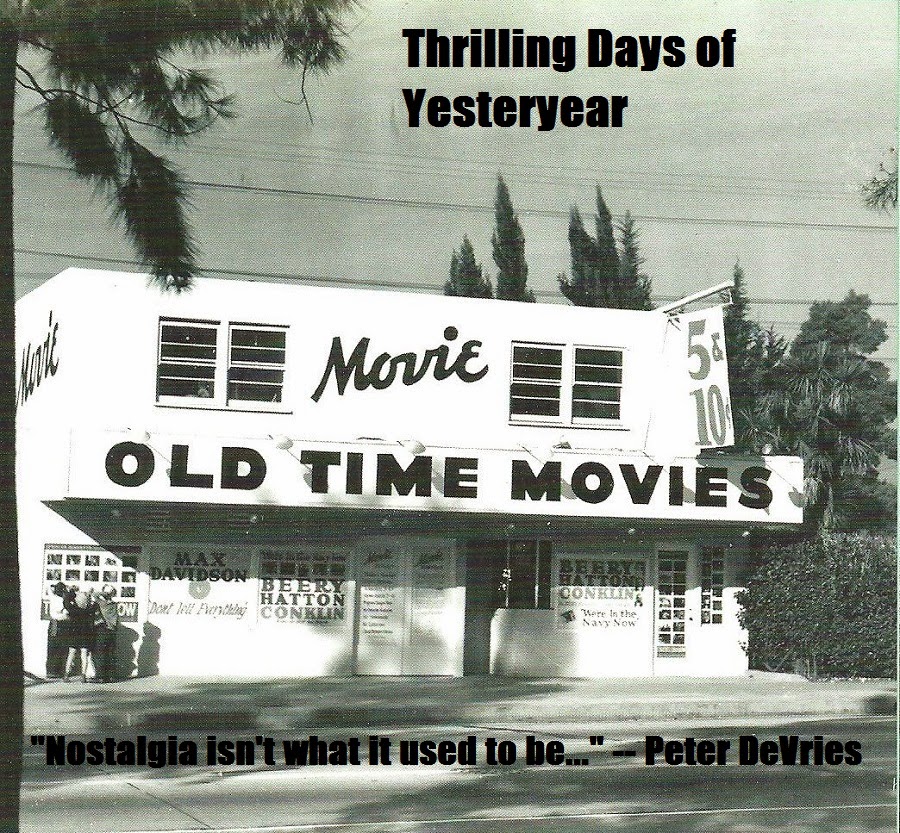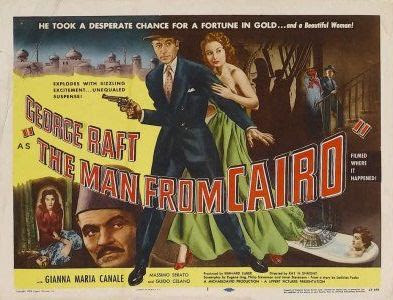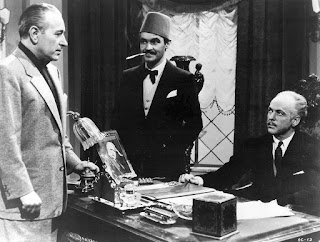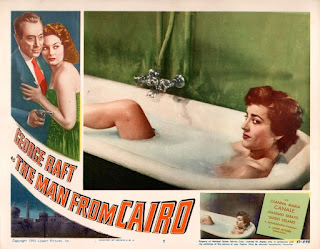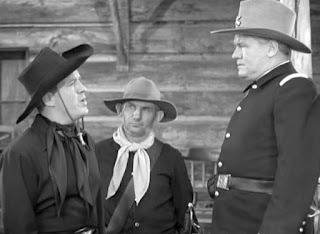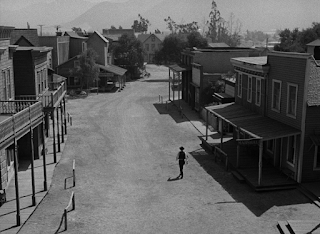So let’s get the full disclosure portion of this post out of
the way.
In Harold “Hal” Erickson’s
From Radio to the Big Screen: Hollywood
Films Featuring Broadcast Personalities and Programs, I’m listed in the
Acknowledgments…and
Thrilling Days of
Yesteryear is mentioned in the Bibliography section (under “Frequently
Referenced Websites”).
I cannot, however,
hammer home enough the point that I would have gravitated to this book
regardless of my miniscule
participation.
(I even paid for the
Kindle copy—thanks to some generous Amazon gift card largesse I received from
Facebook compadres and fellow bloggers
Brandie and
Christopher for my natal
anniversary earlier this month.)
Hal is
also one of the many Facebook denizens with whom I interact with on a frequent
basis, since we share a mutual mania for classic movies and other forms of
nostalgia.
Beginning with Rudy Vallee’s
The Vagabond Lover in 1929 (though it’s more accurate to mention
that the first “broadcast personality,” “Radio Girl” Ann Howe, was appearing in
silent films beginning in 1926) and concluding with the silver screen take on
A Prairie Home Companion (2006), author
Erickson treats us to a staggeringly comprehensive look at how the motion
picture industry mined a rich vein of film fodder making movies based on the
popular radio programs of the day.
The
material is presented in a chronological fashion, delving into films from the
1930s (
Check and Double Check,
Paramount’s “Big Broadcast” franchise), the 1940s (most of Columbia’s B-picture
series, like
Crime Doctor and
The Whistler), and the 1950s (
The Fat Man,
Pete Kelly’s
Blues).
The end of the road is
arrived at with sections on the aforementioned
Companion and
Private Parts
(1997); admittedly, I skipped over the chapter on the Howard Stern movie
because a) I’d already seen it, and b) still don’t know what all the fuss was
about.
What
won’t you
find in
From Radio to the Big Screen?
Well, talents like Eddie Cantor and Bob Hope
have been excised; Cantor was actually well-known as a stage personality and
film star (
Whoopee!,
Palmy Days) before his appearance on
the Rudy Vallee series and subsequent
Chase and Sanborn Program in
1931.
The same applies for Hope, who had
already established his Broadway bona fides before his successful show for
Pepsodent debuted in the fall of 1938 (Hope had appeared in two-reelers as
early as 1934, and his prolific film career was technically not jumpstarted by
his radio show, but by his star-making role in
The Big Broadcast of 1938).
(If
you’re curious to examine the cinematic oeuvre of Hope in more detail, I highly
recommend my Facebook amigo Jim Neibaur’s
The Bob Hope Films—not available for
Kindle, unfortunately.)
With rare
exceptions (Hope’s in-joke joshing with Bing Crosby in the “Road” films, Cantor
in
Thank Your Lucky Stars), both
comedians took special care to separate their cinematic vehicles from their
radio shows by playing different characters in their films.
You will, however, find entries on Cantor
stooges Harry “Parkyakarkus” Einstein and Bert “The Mad Russian” Gordon, and
the cinematic oeuvre of Hope regulars like Jerry Colonna, Brenda & Cobina
(Elvia Allman & Blanche Stewart), and Vera Vague (Barbara Jo Allen) are
also discussed.
The same Cantor-Hope principle is applied to aural medium
funsters like Red Skelton and Abbott & Costello (who would have succeeded
in the movies, Erickson argues, regardless of radio), plus you won’t find films
in such franchises as
The Falcon or
Boston Blackie because they were
already well-established literary properties and/or movies before they branched
out to the airwaves.
Hal makes
exceptions for series like
Henry Aldrich
(he had his origins on the Broadway stage, with
What a Life!) and
Scattergood
Baines (whose short stories began
publication in 1917) with the reasoning that those movies sprung from the
success of their respective radio programs.
Hal isn’t quite as appreciative of the Aldrich films as I am, though he
does note that “the films provide a farcical antidote to the sickly
wholesomeness of MGM’s concurrently produced
Andy Hardy films” (starring, of course,
TDOY bête noire Mickey
Rooney).
I’d be curious to check out
some of the
Scattergood Baines
entries; if The Greatest Cable Channel Known to Mankind™ does own the R-K-O
library, it’s a shame they don’t feature one or two these whenever they have a
“Guy Kibbee Day.”
Serials based on
characters like
The Lone Ranger and
The Green Hornet get the nod for this
volume…other chapter plays featuring
Buck
Rogers or
Terry and the Pirates
(both well-established comic strip properties) do not.
Hal does present sections on Edgar Bergen & Charlie
McCarthy (even though Bergen was making shorts for Vitaphone before his radio
program), Jack Benny (limiting those movie mentions to when Benny performed in
his radio persona, such as
Buck Benny Rides Again), and Fred
Allen.
This is from the
“Acknowledgements” in his book: “After screening my copy of the Fred Allen
movie vehicle
It’s in the Bag (1945) for an
old-time radio fan club, I was surprised that the picture elicited very few
laughs, and was blown off as a waste of time once the screening ended.”
(I don’t want to meet any of these people…
ever!)
Erickson continues: “However, these same radio aficionados have no
problem listening to radio adaptations of popular Hollywood films on such
anthologies of the 1930s and 1940s as
Lux Radio Theater and
Screen
Director’s Playhouse.
The only
explanation I can come up with for this paradox is that fans of classic radio
(or even modern-day radio) prefer to exercise their imaginations and conjure up
images of their favorite stars and programs, and feel a bit resentful when these
‘word pictures’ are literalized on film by others, almost as if some enemy
force had invaded their minds and imposed an alien set of images.”
I might also add here that while these same
people might have little difficulty
listening
to these radio adaptations
buying
them is an entirely different matter, if what some folks who sell OTR for a living
tell me is true about sluggish sales.
“Erickson is one of those select few writers who can always
be counted on to produce a quality book,” writes a reviewer at
Classic Images.
“His writing is informative, breezy, and most
entertaining.
I never have to worry
about the information contained in one of his books; in fact, I learn a great
deal from his impeccable research…he also sprinkles his text with interesting
tidbits.”
CI is pretty spot-on in their
review of Hal’s book—I love what he writes and how he writes, and sorely miss
his entertaining capsule reviews at
AllMovie
(he was a Senior Editor at that site for 15 years—when it was still
allmovieguide.com—and seemed to be one of the few individuals who had actually
seen the films he wrote about).
From
Radio to the Big Screen isn’t completely error-free: Hal states that the
December 30, 1936 broadcast of
Town Hall Tonight—the spark that
ignited the Jack Benny-Fred Allen “feud”—doesn’t exist but you’ll find the
entire broadcast on the Radio Spirits
collection
Jack
Benny vs. Fred Allen: The Feud (little shout-out to my
employers there).
This is just a pin
prick of a nitpick; the entries in his book are a delight to read, and he generously
calls attention to movies that should be better known and appreciated (he and I
share a mutual affection for 1952’s
Here
Come the Nelsons).
